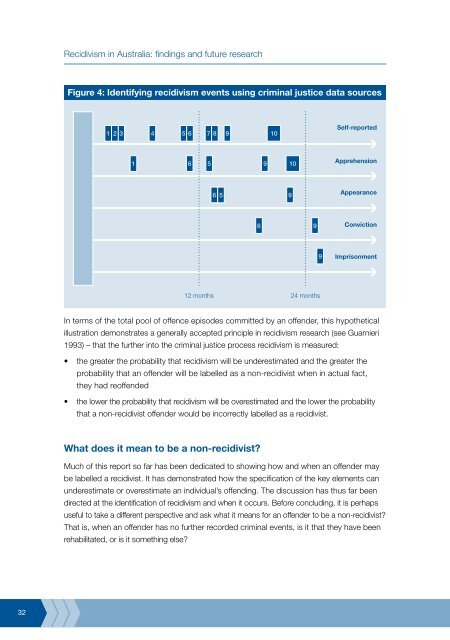Recidivism in Australia : findings and future research - Australian ...
Recidivism in Australia : findings and future research - Australian ...
Recidivism in Australia : findings and future research - Australian ...
Create successful ePaper yourself
Turn your PDF publications into a flip-book with our unique Google optimized e-Paper software.
32<br />
<strong>Recidivism</strong> <strong>in</strong> <strong>Australia</strong>: f<strong>in</strong>d<strong>in</strong>gs <strong>and</strong> <strong>future</strong> <strong>research</strong><br />
Figure 4: Identify<strong>in</strong>g recidivism events us<strong>in</strong>g crim<strong>in</strong>al justice data sources<br />
In terms of the total pool of offence episodes committed by an offender, this hypothetical<br />
illustration demonstrates a generally accepted pr<strong>in</strong>ciple <strong>in</strong> recidivism <strong>research</strong> (see Guarnieri<br />
1993) – that the further <strong>in</strong>to the crim<strong>in</strong>al justice process recidivism is measured:<br />
•<br />
•<br />
1 2 3 4 5 6 7 8 9 10<br />
the greater the probability that recidivism will be underestimated <strong>and</strong> the greater the<br />
probability that an offender will be labelled as a non-recidivist when <strong>in</strong> actual fact,<br />
they had reoffended<br />
1<br />
the lower the probability that recidivism will be overestimated <strong>and</strong> the lower the probability<br />
that a non-recidivist offender would be <strong>in</strong>correctly labelled as a recidivist.<br />
What does it mean to be a non-recidivist?<br />
6<br />
5<br />
6 5<br />
9 10<br />
Self-reported<br />
Apprehension<br />
Appearance<br />
Conviction<br />
Imprisonment<br />
Much of this report so far has been dedicated to show<strong>in</strong>g how <strong>and</strong> when an offender may<br />
be labelled a recidivist. It has demonstrated how the specification of the key elements can<br />
underestimate or overestimate an <strong>in</strong>dividual’s offend<strong>in</strong>g. The discussion has thus far been<br />
directed at the identification of recidivism <strong>and</strong> when it occurs. Before conclud<strong>in</strong>g, it is perhaps<br />
useful to take a different perspective <strong>and</strong> ask what it means for an offender to be a non-recidivist?<br />
That is, when an offender has no further recorded crim<strong>in</strong>al events, is it that they have been<br />
rehabilitated, or is it someth<strong>in</strong>g else?<br />
9<br />
6 9<br />
12 months 24 months<br />
9















